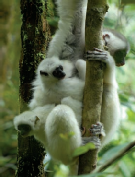![]() Deep in the Madagascar rainforest, a grad student studies furry endangered primates
Deep in the Madagascar rainforest, a grad student studies furry endangered primates
Deep in the Madagascar rainforest, a grad student studies furry endangered primates
For weeks at a time, grad student Erik Patel wakes at 5 a.m. in a bungalow near a cliff's edge, eats a breakfast of condensed milk and oats, then wades through the river separating his campsite from the arboreal homes of his elusive research subjects: silky sifaka lemurs. Since 2001, the PhD candidate in biological psychology has been studying the behavior of the fluffy white mammals, which can be found only in the mountainous rainforests of northeastern Madagascar. "They look as if they wear white fur coats and big, black, round sunglasses," says Patel, who holds a bachelor's degree in psychology from Indiana's Earlham College and a master's in biological anthropology from Berkeley. "Maybe a cross between a small polar bear and a raccoon."

Though the silky sifakas have only one natural predator—the small, puma-like fossa— they're one of the world's twenty-five most critically endangered primates, a situation made more severe by their inability to survive in captivity. Largely due to hunting, slash-and-burn agriculture, and illegal rose-wood logging, the silky sifaka population is dwindling. Patel has observed about 130 of the lemurs, but estimates there are 300 to 2,000 in the country.
What began with Patel and a couple of Cornell undergrads scouring the rainforest for the lemurs has grown to involve many of the local villagers. Patel enlists their help in tracking the lemurs and has developed educational programs, giving presentations to primary schools and taking kids on tours of his campsite. "You'd be amazed how many people live next to Marojejy National Park, where the silky sifakas are mainly found, and have never seen the animal," says Patel, whose work has been the subject of several documentary films, including one currently in production by the BBC.

Patel's first trip to Madagascar was in 2000, when he volunteered at an established research station "collecting lemur poop." Since the lemurs spend much of their lives twenty yards up in the rainforest canopy, observing them requires a combination of acute observation and sheer luck. When he returned the following year, he spent five weeks hiking through the park before finding any silky sifakas—and when he did, the lemurs were scared of him, making alarm calls and running away. But after about six months they began to trust Patel and his companions. "We have names for all of them," says Patel, "and we can tell them apart by eye."
While his trips to Madagascar vary in length, Patel generally spends about six months a year there. After he receives his PhD—he hopes to finish in December—he will work for Duke University's Lemur Center, living in Madagascar ten months a year. He will also continue running his nonprofit, SIMPONA, which he established in 2010 as a vehicle for donations and grant funding. "People don't realize that so many animals have already gone extinct and we knew nothing about them," he says. "We are responsible for their extinction, so the least we can do is try to learn about them for future generations."
— Natanya Auerbach '13
{vimeo}25109845{/vimeo}
Trouble in Lemur Land (48:45)


